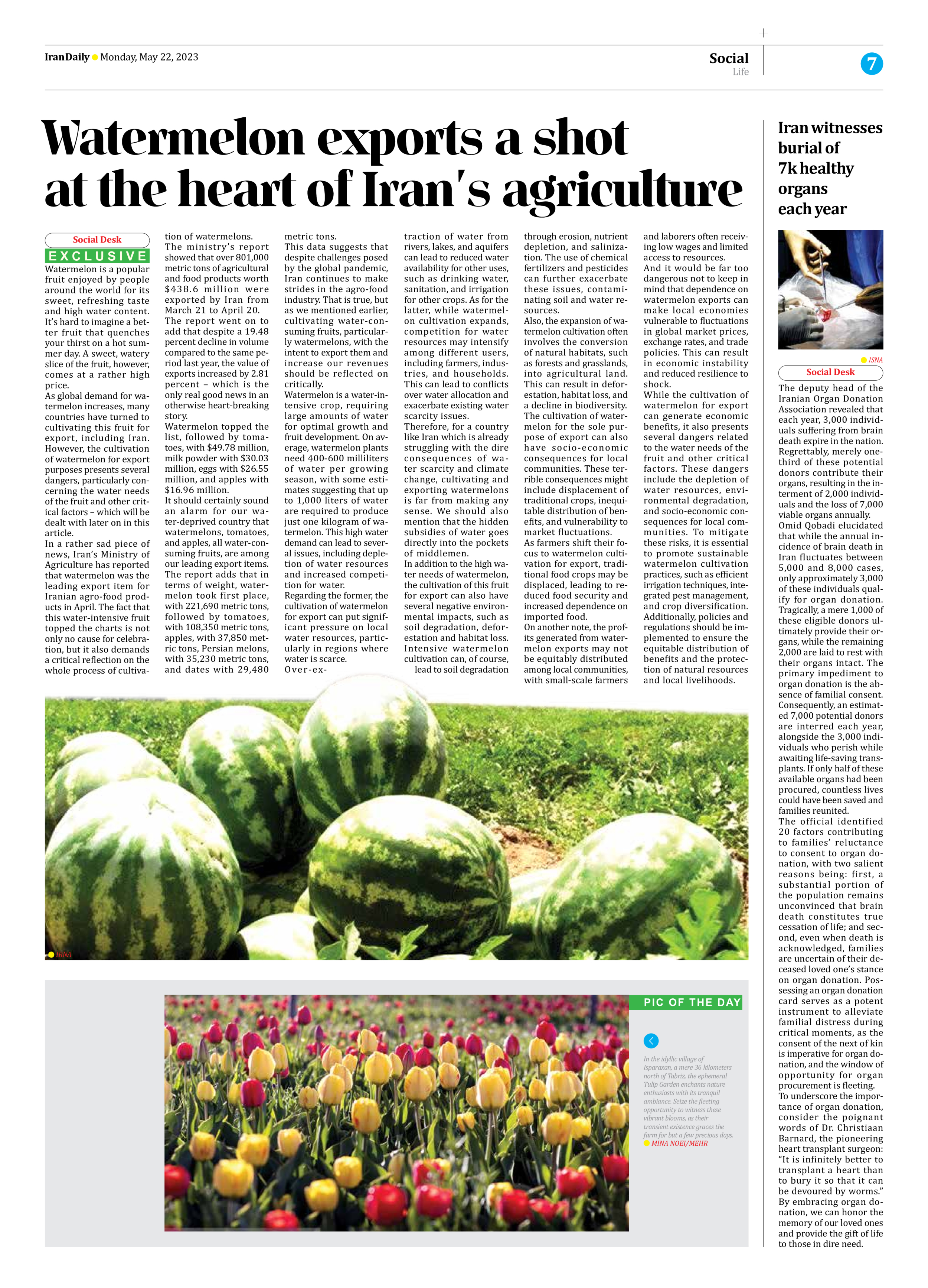
Watermelon exports a shot at the heart of Iran’s agriculture
Watermelon is a popular fruit enjoyed by people around the world for its sweet, refreshing taste and high water content. It’s hard to imagine a better fruit that quenches your thirst on a hot summer day. A sweet, watery slice of the fruit, however, comes at a rather high price.
As global demand for watermelon increases, many countries have turned to cultivating this fruit for export, including Iran. However, the cultivation of watermelon for export purposes presents several dangers, particularly concerning the water needs of the fruit and other critical factors – which will be dealt with later on in this article.
In a rather sad piece of news, Iran’s Ministry of Agriculture has reported that watermelon was the leading export item for Iranian agro-food products in April. The fact that this water-intensive fruit topped the charts is not only no cause for celebration, but it also demands a critical reflection on the whole process of cultivation of watermelons.
The ministry’s report showed that over 801,000 metric tons of agricultural and food products worth $438.6 million were exported by Iran from March 21 to April 20.
The report went on to add that despite a 19.48 percent decline in volume compared to the same period last year, the value of exports increased by 2.81 percent – which is the only real good news in an otherwise heart-breaking story.
Watermelon topped the list, followed by tomatoes, with $49.78 million, milk powder with $30.03 million, eggs with $26.55 million, and apples with $16.96 million.
It should certainly sound an alarm for our water-deprived country that watermelons, tomatoes, and apples, all water-consuming fruits, are among our leading export items.
The report adds that in terms of weight, watermelon took first place, with 221,690 metric tons, followed by tomatoes, with 108,350 metric tons, apples, with 37,850 metric tons, Persian melons, with 35,230 metric tons, and dates with 29,480 metric tons.
This data suggests that despite challenges posed by the global pandemic, Iran continues to make strides in the agro-food industry. That is true, but as we mentioned earlier, cultivating water-consuming fruits, particularly watermelons, with the intent to export them and increase our revenues should be reflected on critically.
Watermelon is a water-intensive crop, requiring large amounts of water for optimal growth and fruit development. On average, watermelon plants need 400-600 milliliters of water per growing season, with some estimates suggesting that up to 1,000 liters of water are required to produce just one kilogram of watermelon. This high water demand can lead to several issues, including depletion of water resources and increased competition for water.
Regarding the former, the cultivation of watermelon for export can put significant pressure on local water resources, particularly in regions where water is scarce. Over-extraction of water from rivers, lakes, and aquifers can lead to reduced water availability for other uses, such as drinking water, sanitation, and irrigation for other crops. As for the latter, while watermelon cultivation expands, competition for water resources may intensify among different users, including farmers, industries, and households. This can lead to conflicts over water allocation and exacerbate existing water scarcity issues.
Therefore, for a country like Iran which is already struggling with the dire consequences of water scarcity and climate change, cultivating and exporting watermelons is far from making any sense. We should also mention that the hidden subsidies of water goes directly into the pockets of middlemen.
In addition to the high water needs of watermelon, the cultivation of this fruit for export can also have several negative environmental impacts, such as soil degradation, deforestation and habitat loss.
Intensive watermelon cultivation can, of course, lead to soil degradation through erosion, nutrient depletion, and salinization. The use of chemical fertilizers and pesticides can further exacerbate these issues, contaminating soil and water resources.
Also, the expansion of watermelon cultivation often involves the conversion of natural habitats, such as forests and grasslands, into agricultural land. This can result in deforestation, habitat loss, and a decline in biodiversity.
The cultivation of watermelon for the sole purpose of export can also have socio-economic consequences for local communities. These terrible consequences might include displacement of traditional crops, inequitable distribution of benefits, and vulnerability to market fluctuations.
As farmers shift their focus to watermelon cultivation for export, traditional food crops may be displaced, leading to reduced food security and increased dependence on imported food.
On another note, the profits generated from watermelon exports may not be equitably distributed among local communities, with small-scale farmers and laborers often receiving low wages and limited access to resources.
And it would be far too dangerous not to keep in mind that dependence on watermelon exports can make local economies vulnerable to fluctuations in global market prices, exchange rates, and trade policies. This can result in economic instability and reduced resilience to shock.
While the cultivation of watermelon for export can generate economic benefits, it also presents several dangers related to the water needs of the fruit and other critical factors. These dangers include the depletion of water resources, environmental degradation, and socio-economic consequences for local communities. To mitigate these risks, it is essential to promote sustainable watermelon cultivation practices, such as efficient irrigation techniques, integrated pest management, and crop diversification. Additionally, policies and regulations should be implemented to ensure the equitable distribution of benefits and the protection of natural resources and local livelihoods.







